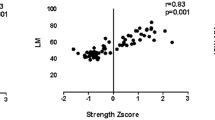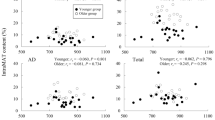Abstract
In order to investigate the effect of gender, age and level of obesity on body composition and anaerobic power output, and to test the hypothesis that variation in body composition affects muscle power output in obesity, a cohort of 377 subjects (112 males and 265 females, aged 18–75 yr) with different levels of obesity [class IIII, body mass index (BMI) range: 30.6–60.3 kg mp−2] was cross-sectionally investigated. Body composition was assessed with bioelectric impedance analysis (BIA), in standardized conditions and using obesity-specific prediction formulas. Lower limb anaerobic power output (W ? ) was measured with a modification of the Margaria stair climbing test. In males, a similar increase in fat-free mass (FFM) and fat mass (FM) was observed as a function of BMI, while in females, FM increased more than FFM. In both genders, FFM significantly decreased as a function of age (p<0.001), but was higher in men of all ages. Similar patterns of variation were observed in W. A differently significant correlation between BMI and W was observed between men and women, and it was found by multivariate analysis of variance (MANOVA) that W ? was affected negatively by age (p<0.001) and positively by BMI (p<0.001) in males, while in females only age had a significant effect (p<0.001) but not BMI. A positive correlation (p<0.001) was detected between FFM and .W, in both genders. .W per unit body mass, the actual muscle power for rapid external work, was higher in men than in women of all groups, and decreased with age in both genders, but only in older women decreased significantly (p<0.01) depending on BMI. It is concluded that the gender-dependent pattern of variation in body composition may be an important determinant of the different motor limitations observed in men and women. Older women (≥50 yr) with extreme obesity (class III) suffered from the most serious motor dysfunction within this obese cohort. This result may have important clinical relevance in the care of obesity.
Similar content being viewed by others
References
Visscher TLS, Seidell JC. The public health impact of obesity. Annu Rev Public Health 2001; 22: 355–75.
Flegal KM. The obesity epidemic in children and adults: current evidence and research issues. Med Sci Sports Exerc 1999; 31: S509–14.
Mokdad AH, Serdula MK, Dietz WH, Bowman BA, Marks JS, Koplan J P. The continuing epidemic of obesity in the United States. JAMA 2000; 284: 1650–1.
Han TS, Tijhuis MA, Lean ME, Seidall JC. Quality of life in relation to overweight and body fat distribution. Am J Public Health 1998; 88: 1814–20.
Doll HA, Petersen SEK, Stewart-Brown SL. Obesity and physical and emotional well-being: association between body mass index, chronic illness, and the physical and mental components of the SF-36 questionnaire. Obes Res 2000; 8: 160–70.
Larsson U, Karlsson J, Sullivan M. Impact of overweight and obesity on healthrelated quality of life — a Swedish population study. Int J Obes Relat Metab Disord 2002; 26: 417–24.
Hulens M, Vansant G, Lysens R, Claessens AL, Muls E. Exercise capacity in lean versus obese women. Scand J Med Sci Sports 2001; 11: 305–9.
Barofsky I, Fontaine KR, Cheskin LJ. Pain in the obese: impact on health-related quality-of-life. Ann Behav Med 1998; 19: 408–10.
Lafortuna CL, Fumagalli E, Vangeli V, Sartorio A. Lower limb alactic anaerobic power output assessed with different techniques in morbid obesity. J Endocrinol Invest 2002; 25: 134–41.
Sartorio A, Fontana P, Trecate L, Lafortuna CL. Short-term changes of fatigability and muscle performance in severe obese patients after an integrated body mass reduction program. Diabetes Nutr Metab 2003; 16: 88–93.
Evers Larsson UE, Mattsson E. Perceived disability and observed functional limitations in obese women. Int J Obes Relat Metab Disord 2001; 25: 1705–12.
Evers Larsson U, Mattsson E. Functional limitations linked to high body mass index, age and current pain in obese women. Int J Obes Relat Metab Disord 2001; 25: 893–9.
Lukaski HC, Bolonchuk WW, Hall CB, Siders WA. Validation of tetrapolar bioelectrical measurements to assess human body composition. J Appl Physiol 1986; 60: 1327–32.
Gray DS, Bray GA, Gemayel N, Kaplan K. Effects of obesity on bioelectrical impedance. Am J Clin Nutr 1989; 50: 255–60.
Margaria R, Aghemo P, Rovelli E. Measurement of muscular power (anaerobic) in man. J Appl Physiol 1966; 21: 1662–4.
Sartorio A, Narici MV, Fumagalli E, Faglia G, Lafortuna CL. Aerobic and anaerobic performance before and after a short-term body mass reduction program in obese subjects. Diab Nutr Metab 2001; 14: 51–7.
Clinical guidelines on the identification, evaluation, and treatment of overweight and obesity in adults. The evidence report. NIH publication no. 98–4083, September 1998, National Institute of Health.
Zar JH. Biostatistical analysis. Englewood Cliff, NJ: Prentice-Hall International Editions, USA, 1984, 292–305.
Kyle UG, Genton L, Slosman DO, Pichard C. Fat-free and fat mass percentiles in 5225 healthy subjects aged 15 to 98 years. Nutrition 2001; 17: 534–41.
Heitmann BL. Body fat in the adult Danish population aged 35-65 years: an epidemiological study. Int J Obes Relat Metab Disord 1991; 15: 535–45.
Frontera WR, Hughes VA, Lutz KJ, Evans WJ. A cross-sectional study of muscle strength and mass in 45- to 78-yr-old men and women. J Appl Physiol 1991; 71: 644–50.
Ivey FM, Roth SM, Ferrell RE et al. Effects of age, gender, and myostatin genotype on the hypertrophic response to heavy resistance strength training. J Gerontol A Biol Sci Med Sci 2000; 55: M641–8.
Sartorio A, Proietti M, Marinone PG, Agosti F, Adorni F, Lafortuna CL. Influence of gender, age and BMI on lower limb muscular power output in a large population of obese men and women. Int J Obes Relat Metab Disord 2004, 28: 91–8.
Young A. Ageing and physiological functions. Philos Trans R Soc Lond B Biol Sci 1997; 352: 1837–43.
Hakkinen K, Pakarinen A. Muscle strength and serum testosterone, cortisol and SHBG concentrations in middle-aged and elderly men and women. Acta Physiol Scand 1993; 148: 199–207.
Izquierdo M, Aguado X, Gonzalez R, Lopez JL, Hakkinen K. Maximal and explosive force production capacity and balance performance in men of different ages. Eur J Appl Physiol Occup Physiol 1999; 79: 260–7.
Narici M, Bordini M, Cerretelli P. Effect of aging on human adductor pollicis muscle function. J Appl Physiol 1991; 71: 1227–81.
Lindle RS, Metter EJ, Lynch NA et al. Age and gender comparison of muscle strength in 654 women and men aged 20–93 yr. J Appl Physiol 1997; 83: 1581–7.
Izquierdo M, Ibanez J, Gorostiaga E et al. Maximal strength and power characteristics in isometric and dynamic actions of the upper and lower extremities in middle-aged and older men. Acta Physiol Scand 1999; 167: 57–68.
De Vito G, Bernardi M, Forte R, Pulejo C, Macaluso A, Figura F. Determinants of maximal instantaneous muscle power in women aged 50–75 years. Eur J Appl Physiol Occup Physiol 1998; 78: 59–64.
Levy DI, Young A, Skelton DA, Yeo A-L. Strength, power and functional ability. In: Passeri M eds. Geriatrics ’94. Rome: CIC Edizioni Internazionali. 1994, 85–93.
Author information
Authors and Affiliations
Corresponding author
Rights and permissions
About this article
Cite this article
Lafortuna, C.L., Agosti, F., Marazzi, N. et al. The relationship between body composition and muscle power output in men and women with obesity. J Endocrinol Invest 27, 854–861 (2004). https://doi.org/10.1007/BF03346280
Accepted:
Published:
Issue Date:
DOI: https://doi.org/10.1007/BF03346280




